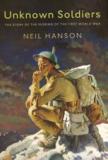Resting Places
In 1969 the Apollo astronaut Edwin Aldrin described the “magnificent desolation” of the moon. As the United States reflects on its lengthening wars in Iraq and Afghanistan this Veterans Day, the issue of how most appropriately to honor soldiers who have died in battle is elevated profoundly through the “magnificent desolation” that is Neil Hanson’s narrative of soldierly burial in World War I. Unknown Soldiers is a book very much written in the spirit of the famous funeral reading from Wis 3:1-9, which describes the “affliction” and “utter destruction” of the battle deaths but also shows how the funeral rites developed during that war strengthened the convictions of survivors that “the souls of the just are in the hands of God.”
The British historian and writer Neil Hanson observes that bereavement during World War I was particularly painful because of contradictory results of modern technology. At a time when medical advances had made it reasonably likely that parents in industrialized countries might hope never to see the natural deaths of their children, modern weaponry blazed forth its capacity for efficient mass slaughter. Aware of the contradiction, governments sought to provide meaningful tribute to the war dead in ways that would soften awareness of the volume of casualties.
The United States encouraged women to abandon heavy Victorian mourning dress for the alternative of wearing a gold star on a black armband. British dominions built cenotaphs, empty monuments that symbolized the many whose bodies would not return home. A British chaplain, however, David Railton, invented the most popular tribute when he proposed designating the body of one representative unknown soldier for a symbolic burial at home. This practice, copied by several belligerent nations, provided focal points of mourning for the mass of bereaved families.
Hanson first presents the specific stories of three fallen soldiers of the war—Paul Hub of Germany, Alec Reader of Britain and George Seibold of the United States. All died in the vicinity of the Somme River in France, but no identifiable remains have ever been found for any of them. He then traces the invention of the unknown soldier concept and provides lengthy accounts of the British and American funerals for their unknowns.
The heartbreaking first section of the book brings each of the three soldiers to life through detailed examinations of both their civilian lives and war experiences. Comparatively little attention is paid to the underlying issues of the war. Instead, the emphasis is on how each of these three soldiers lost lives filled with hope. There were at least three million casualties during the war, but Hanson needs only three such cases to illuminate the tragedy of them all. Hanson is particularly astute to discuss Hub first; the reader quickly learns that enemy troops have essentially the same personal struggles as those of any soldier. A particularly valuable part of Hub’s story is the account of the little-known effect of the British blockade of Germany during World War I on the living conditions of his family. Hanson should have provided more discussion of how the Hub family and their nation continued to grieve after Germany had lost the war. How, for example, did Germany respond to the elaborate funeral rites carried out in the victorious nations?
This book has a deeply reflective spiritual tone. Hanson’s tactic of allowing the three soldiers’ stories simply to unfold creates a hauntingly beautiful tale of lost dreams, which led me to pause and reflect at numerous points in the narrative. This spiritual aspect could be enhanced if the book had more theological content. In particular, there is no clarity concerning resurrection of the body. Hanson realizes that honoring the war dead was linked to a sense that their countries would experience national resurrection through the sacrifice of the fallen. Little is said, however, about the concept of personal resurrection for the individual soldier, other than a mention of the fact that George Bernard Shaw imagined but did not write a satirical play in which the British unknown, upon rising, would prove to have been German.
Yet the discerning reader can identify many influences of resurrection faith in the way the dead were honored. Great care was taken to individuate each set of remains and its grave, even when bodies could not be identified. The American Siebold family, in particular, yearned desperately to know the specific burial place for their George. People may not have realized where this emphasis originated, but surely it had roots in the ancient scriptural hope that each individual, not just the mass number of dead, lives on in the memory of God.
More theological content would also highlight an underappreciated fact of the First World War, namely that it was a suicidal civil war among essentially Judeo-Christian nations. During the Second World War in Europe and the later cold war division of the continent, it could be said that one side was essentially Judeo-Christian and the other essentially pagan or atheistic. This dynamic was the horrific consequence of the First World War.
Hanson’s narrative of Paul Hub, a German who lived before the eras of Nazism and Communism, reminds us that the war destroyed any kind of Christian theological consensus about how nations should live together at peace. That is one casualty of the Great War that can indeed be identified, and which has not yet fully come to light.
This article also appeared in print, under the headline “Resting Places,” in the November 13, 2006, issue.








